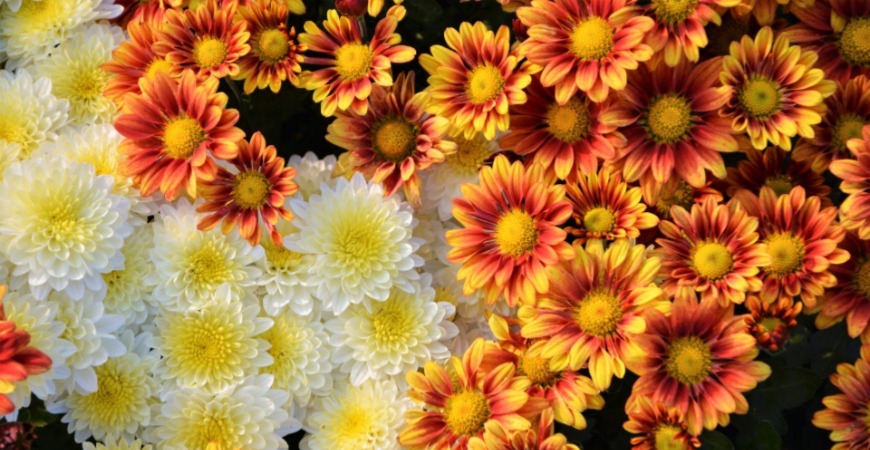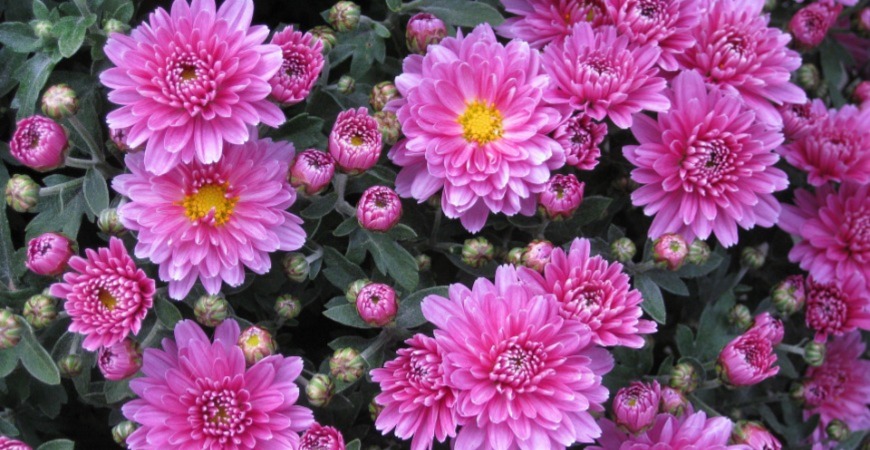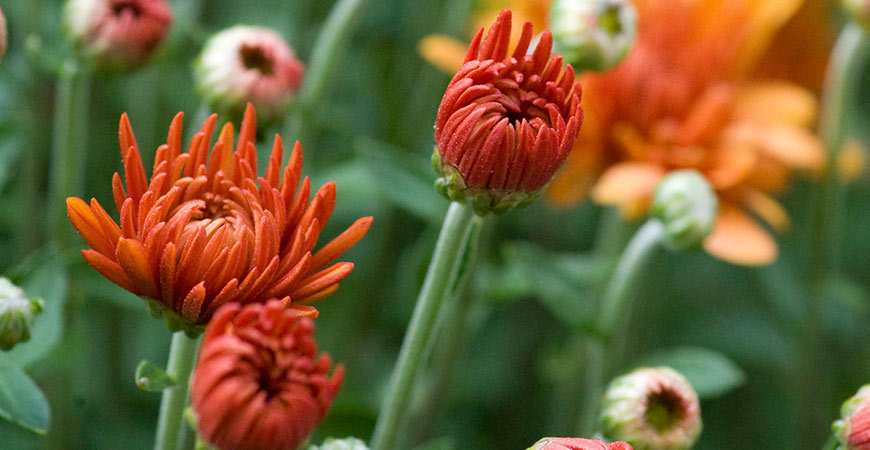
How to Keep Your Chrysanthemums Blooming Past Thanksgiving
Considering their ubiquity, it’s ironic how difficult it can be to maintain blooming chrysanthemums. Overwatering, underwatering, and exposure to practically any stressor can be enough to kill these vibrant and beautiful flowers.
Instead of giving up on mums altogether, check out our guide below on how to keep chrysanthemums blooming. We’ll walk you through the hardiest varieties, how to shop for them, and some straightforward care tips for your potted or planted chrysanthemums.
Choosing the Right Blooming Chrysanthemum
Chrysanthemums are known for their bold, vibrant colors encompassing the entire rainbow. At your local nursery, you’ll find red, white, yellow, and lavender varieties.
When taken care of properly, mums can hold their colors for weeks at a time. However, not all chrysanthemums bloom at the same time, with some beginning to offer their visual bouquet in July and August while others not doing so until late fall.
We’ve previously highlighted some of our favorite varieties, including those with early-season blooms. However, we also want to surface a few of our preferred late-bloomers, too:
- Matchstick Chrysanthemums have yellow, tubular petals that end with red tips, resembling, well, matchsticks. You can plant them in USDA Hardiness Zones 4B to 9, and they typically offer two blooms: one in July and one in October.
- Mei-Kyo Chrysanthemums offer a burst of cotton candy pink and are known to attract butterflies. They’re hardy in zones 5 to 9 and typically bloom mid to late fall.
- Weyrich Chrysanthemums are daisy-like, with delicate pops of color. A dwarf species that doesn’t take up much room in your garden, you can plant them in zones 3 to 8, and they can bloom all the way into November.
Shopping for a Fall Chrysanthemum
Finding a strong, healthy plant is essential for an extended blooming period. Unfortunately, many large retailers underwater their plants, unknowingly stressing them.
So, it’s often better to shop at a nursery or garden store where the flowers are the focus and not an impulse buy. You’re also more likely to find local varieties of mums, which indicates that they should thrive in your climate and hardiness zone.
When choosing a specific flower, check the soil in which it’s planted. It should be moist and not dry.
Additionally, give the flower a quick once-over. Check for healthy, deep green leaves that aren’t wilting or drooping.
If the chrysanthemums don’t look healthy, it will be challenging to nurse them back to life. So, stick to healthy-looking plants.
If you’re looking for a plant to care for long-term, find one with many tight, unopened flower buds. That way, you’ll be able to experience the full bloom throughout the season.
If you’re looking for something more short-term, such as for an upcoming event, find one whose flowers are bright, vibrant, and robust. You likely won’t experience as long as a bloom, but they’re immediately ready for display.
Due to the wide variety of chrysanthemums available, including many exotic ones, don’t hesitate to ask any questions to employees at your local nursery or garden center. They’ll have the best insights into which mums are ideal for your climate and hardiness zone.
Caring for Potted Chrysanthemums
Due to their exquisite color and beauty, chrysanthemums are popular flowers to keep on your front porch, balcony, or even inside. Repotting them after purchase is relatively straightforward, but they can also quickly wilt and die without care or attention.
You can protect your outdoor mums by using containers made from concrete, resin, or terracotta. These materials will help keep the soil warm and moist and weigh the flowers down during wind storms.
First, you’ll want to add a layer of high-quality potting soil to the new pot. Then, remove the mums from the vessel it came in, breaking up the roots as you do so.
Then place your chrysanthemum fall flowers in their new home and add more soil until the roots are covered. You don’t want to pack the soil too tightly, as you want it to absorb water and not push it overboard.
Keep a tray beneath the repotted mums to help keep the soil moist. Underwatering is a common way to shorten your flowers’ blooming season.
Blooming chrysanthemums need at least four to six hours of direct sunlight every day. So, keep an eye on them when you first put them out to ensure they get the necessary sun.
In terms of watering, you’ll need to water them at least once a day — more often if they’re sitting in an area that’s especially hot or sun-drenched. Pour the water directly into the soil to ensure the moisture is absorbed.
You can snip off wilting or dead blossoms to maximize the bouquet’s beauty. However, in some cold environments, the dead flowers can also help keep the plant warm when temperatures drop.
If you are concerned about the cold, dig a small hole in the ground and fit the plant and pot into the soil. If there’s a freeze warning, protect the mums by covering them overnight.
Planting Chrysanthemums in Your Garden
Sometimes a bold burst of color can take your garden from ordinary to extraordinary. Of course, mums are ideal candidates to add such vibrancy.
Before planting them in your garden, make sure the spot you’ve picked gets four to six hours of daily sunlight. You may also consider planting them in a container or raised garden bed to allow for proper drainage.
Once you’ve found the right spot, dig a hole about two times the size of the pot the mums currently sit in. Then carefully set the plant, so it’s even with ground level, and backfill it with garden soil.
To keep them healthy, try providing them with water-soluble plant food. While this isn’t necessary for the flowers to bloom, it can keep them healthy and extend their blooming season.
You can also add a three-inch layer of mulch to help maintain soil temperatures and provide better drainage. Then, give the mums a daily watering until they’re established.
Keeping Your Fall Chrysanthemum Blooming
Chrysanthemums are a fall favorite for a reason, and while they can be easily stressed, with just a few care tips, you can extend their blooming season past Thanksgiving.
For more gardening tips, tricks, and advice, bookmark AskWetAndForget.com right now. We regularly update our blog with the information you need to keep your garden healthy and beautiful.












